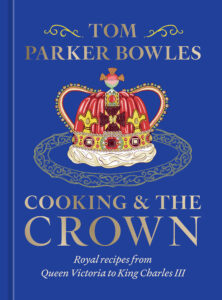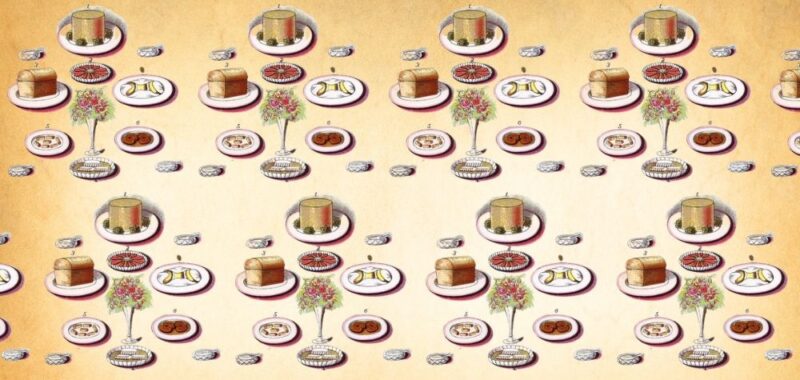“To eat well in England,” the writer W. Somerset Maugham once joked, “you should have breakfast three times a day.” He may have had a point. Because the aristocratic breakfasts of Victorian and Edwardian times were not so much dainty repasts as full-on gastronomic assaults, gut-busting epics that set one up for a good old-fashioned day’s hunting, shooting, and roistering. Or simply getting on with ruling one’s realm.
Article continues after advertisement
Breakfast was served in silver chafing dishes warmed with flickering spirit lamps. And this was the one meal where guests were expected to serve themselves. Well, with the obvious exception of sovereigns. Harold Nicolson, the upper-class polymath, described a typical upper-class spread of:
hams, tongues, galantines, cold grouse, ditto partridge, ditto ptarmigan… the porridge would be disposed of negligently… then would come the whiting, and omelette, and devilled kidneys and little fishy messes in shells. And then scones and marmalade. And then a little melon, and a nectarine, and just one or two of those delicious raspberries.
Breakfasts were, he noted wryly, “in no sense a hurried proceeding.” Okay, so life back then was rather less sedentary, and a lack of central heating meant extra calories helped keep one warm. Still, it would take a hearty appetite to do such a feast justice. An appetite shared, fortuitously, by Queen Victoria and her son, Edward VII.
The aristocratic breakfasts of Victorian and Edwardian times were not so much dainty repasts as full-on gastronomic assaults.
“I remember my surprise on coming down to the kitchens on the first day of my duties,” writes Gabriel Tschumi in his memoir, Royal Chef, “to find that breakfast was as big a meal as the main meal of the day in Switzerland.” He started as an apprentice in the Buckingham Palace kitchen in April 1898 before going on to cook under Edward VII and George V, eventually ending up as royal chef to Queen Mary. Seeing that lunch and dinner were usually ten courses long, he expected that “breakfast would be a very light meal indeed.” How wrong he was.
“I found, instead, that the coal ranges were red-hot and the spits packed with chops, cutlets, steaks, bloaters [whole smoked herring], sausages, chicken and woodcock. The roast chefs were deftly removing them and piling them onto huge platters. In other parts of the kitchen cooks were trimming rashers of streaky bacon, a quarter of an inch thick for grilling, and preparing egg dishes.” The royal family would expect at least five dishes, as did the ladies- and gentlemen-in-waiting, who ate separately. “Any servant could have the same number of courses for breakfast,” he noted. “Quite a number managed it daily without any trouble.”
Queen Victoria enjoyed eating her breakfast en plein air in a tent on the lawn at Frogmore, in Windsor, and at Balmoral. Usually accompanied by the wheeze of bagpipes played by her personal piper—a tradition that goes on to this day. As was typical of contemporary accounts pertaining to the Queen, she was portrayed as having a suitably dainty appetite. “The Queen’s breakfasts are even plainer than her luncheons,” says the anonymous author, thought to be a high-ranking courtier, of The Private Life of the Queen. “Fish is always on the table, but eggs on toast, or merely boiled, with dry toast and a small selection of fancy toast, are the usual articles put before the Queen at her first meal.” The author also notes that “the eggs served at the Queen’s breakfast table are exclusively those of white Dorkings,” from her flock at Windsor.
On her first visit to Scotland in autumn of 1842, “Her Majesty took oatmeal porridge at breakfast, tried the ‘Finnan haddies,’ and pronounced the homely Scottish fare excellent.” Despite the popular myth, there’s no evidence of breakfast curries, although after she was crowned Empress of India two Indian retainers were always at her side.
Victoria’s son, Edward VII, was a magnificent eater, one of history’s great trenchermen. As Sidney Lee, one of his many biographers, pointed out with admirable understatement, the King “never toyed with his food.” Yet at breakfast, he was unusually restrained. “The King was no breakfast eater,” wrote Sir Frederick “Fritz” Ponsonby, his equerry and assistant private secretary, “having only a cup of coffee and a bit of toast.” The exception was made on shooting and racing days. Then, he’d devour small fried soles, bacon, eggs (either poached or en cocotte, a great favorite of his wife, Alexandra, who was as slim as her husband was broad), haddock à l’anglaise, deviled roast chicken, and a couple of becassines sur canapés, or roast woodcock on toast.
It would take a hearty appetite to do such a feast justice.
Edward’s son, George V, was a markedly different character from his epicurean father. A staunch naval man, he’d have been content to survive on military rations and was dependably “regular” in his habits. Five days a week he ate eggs, crisp streaky bacon, and fish, either trout, plaice, or sole. On Saturdays, sausages, too “basted and well-grilled.” The only time he strayed from this routine was when Yarmouth bloaters were in season. These replaced the bangers. His son, George VI, shared his father’s restraint. And the variety of food was not much helped by Second World War rationing, which only ended in 1954, two years after his death.
Times change, along with appetites, although eggs still starred in the breakfasts of Queen Elizabeth II. Alongside orange juice, cereal, and toast. When the royal family gathered at Balmoral or Windsor, there might be kedgeree, oeufs en cocotte, Benedict, or Florentine. The King’s breakfast is simply dried fruit and honey. Queen Camilla has yogurt in summer and porridge in winter. A thoroughly modern, and healthy, start to the day. But I’m not sure Victoria would have approved.
*
Baked Eggs
Baked eggs, also known as oeufs en cocotte, have long been a staple of the royal table, from Queen Victoria to the present day. The Duke of Windsor was a particular fan. This was also a favorite dish from my childhood, usually devoured when we returned home from our holidays, when the fridge and larder were bare. My mother would use eggs from our chickens. Swap the ham or spinach with steamed asparagus, when in season.
Serves 2
2 Tbsp chopped ham or chopped cooked spinach
4 eggs
2 Tbsp heavy cream, divided 4 tsp unsalted butter, divided
Salt and freshly ground black pepper
Hot toast for serving
You will need
2 ovenproof ramekins
*
Preheat the oven to 350°F/175°C.
Divide the ham or spinach between the ramekins. Crack 2 eggs into each ramekin, keeping the yolks intact, then add 1 Tbsp of the cream and 2 tsp of the butter to each and season with salt and pepper.
Put the ramekins in a baking pan and carefully pour enough boiling water into the pan to reach halfway up the sides of the ramekins. Bake for 7 to 10 minutes, until the yolks are wobbling and the whites are just set.
Serve with toast.
__________________________________

Reprinted with permission from Cooking and the Crown: Royal Recipes from Queen Victoria to King Charles III by Tom Parker Bowles. Copyright © 2024. Published by Ten Speed Press, an imprint of Penguin Random House LLC.

